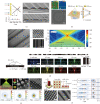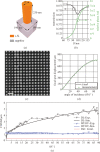Optical metalenses: fundamentals, dispersion manipulation, and applications
- PMID: 36637532
- PMCID: PMC9756243
- DOI: 10.1007/s12200-022-00017-4
Optical metalenses: fundamentals, dispersion manipulation, and applications
Abstract
Metasurfaces, also known as 2D artificial metamaterials, are attracting great attention due to their unprecedented performances and functionalities that are hard to achieve by conventional diffractive or refractive elements. With their sub-wavelength optical scatterers, metasurfaces have been utilized to freely modify different characteristics of incident light such as amplitude, polarization, phase, and frequency. Compared to traditional bulky lenses, metasurface lenses possess the advantages of flatness, light weight, and compatibility with semiconductor manufacture technology. They have been widely applied to a range of scenarios including imaging, solar energy harvesting, optoelectronic detection, etc. In this review, we will first introduce the fundamental design principles for metalens, and then report recent theoretical and experimental progress with emphasis on methods to correct chromatic and monochromatic aberrations. Finally, typical applications of metalenses and corresponding design rules will be presented, followed by a brief outlook on the prospects and challenges of this field.
Keywords: Chromatic and monochromatic aberrations; Flat optics; Metalenses; Metasurfaces; Nanophotonics.
© 2022. The Author(s).
Conflict of interest statement
The authors declare that they have no competing interests.
Figures



















Similar articles
-
Chromatic Dispersion Manipulation Based on Metalenses.Adv Mater. 2020 Jul;32(27):e1904935. doi: 10.1002/adma.201904935. Epub 2019 Dec 11. Adv Mater. 2020. PMID: 31823480 Review.
-
Recent advancements of metalenses for functional imaging.Nano Converg. 2023 May 24;10(1):24. doi: 10.1186/s40580-023-00372-8. Nano Converg. 2023. PMID: 37222959 Free PMC article. Review.
-
Ultrathin van der Waals Metalenses.Nano Lett. 2018 Nov 14;18(11):6961-6966. doi: 10.1021/acs.nanolett.8b02875. Epub 2018 Oct 15. Nano Lett. 2018. PMID: 30296107
-
At-will chromatic dispersion by prescribing light trajectories with cascaded metasurfaces.Light Sci Appl. 2020 May 27;9:93. doi: 10.1038/s41377-020-0335-7. eCollection 2020. Light Sci Appl. 2020. PMID: 32528667 Free PMC article.
-
Metalens-Based Miniaturized Optical Systems.Micromachines (Basel). 2019 May 8;10(5):310. doi: 10.3390/mi10050310. Micromachines (Basel). 2019. PMID: 31071944 Free PMC article. Review.
Cited by
-
Quasi-Freeform Metasurfaces for Wide-Angle Beam Deflecting and Splitting.Nanomaterials (Basel). 2023 Mar 24;13(7):1156. doi: 10.3390/nano13071156. Nanomaterials (Basel). 2023. PMID: 37049250 Free PMC article.
-
AI-Based Metamaterial Design.ACS Appl Mater Interfaces. 2024 Jun 12;16(23):29547-29569. doi: 10.1021/acsami.4c04486. Epub 2024 May 29. ACS Appl Mater Interfaces. 2024. PMID: 38808674 Free PMC article. Review.
-
Plasmonic Coupled Modes in a Metal-Dielectric Periodic Nanostructure.Micromachines (Basel). 2023 Aug 31;14(9):1713. doi: 10.3390/mi14091713. Micromachines (Basel). 2023. PMID: 37763875 Free PMC article.
-
Recent Advances in Tunable Metasurfaces and Their Application in Optics.Nanomaterials (Basel). 2023 May 13;13(10):1633. doi: 10.3390/nano13101633. Nanomaterials (Basel). 2023. PMID: 37242049 Free PMC article. Review.
-
Broadband angular spectrum differentiation using dielectric metasurfaces.Nat Commun. 2024 Mar 12;15(1):2237. doi: 10.1038/s41467-024-46537-9. Nat Commun. 2024. PMID: 38472224 Free PMC article.
References
Publication types
LinkOut - more resources
Full Text Sources
Other Literature Sources

